CW76 January, 2023
The eighth wave of COVID-19 is subsiding, but lasting
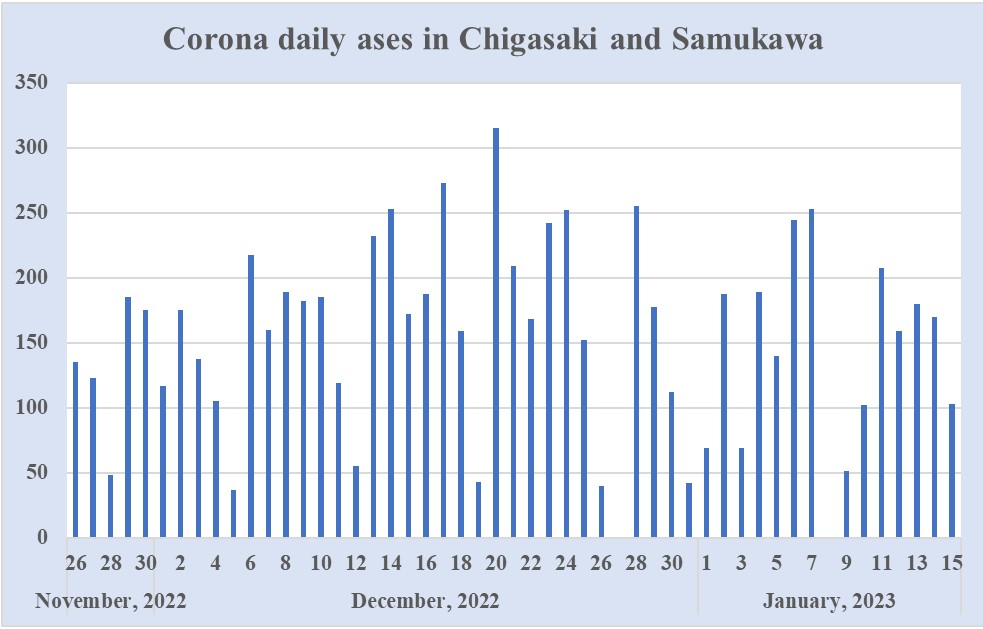
The figure above indicates the eighth wave seems to have passed its peak. However, the daily death toll has been increasing sharply since the end of last year, even though the total number of infected people in the eighth wave appears not to have exceeded that of the previous outbreak.
Experts are afraid that the actual number of infected people is larger than the government statistics, and infection has spread more than the seventh wave.
The media frequently reports almost all beds reserved for corona patients are occupied at most hospitals, and ambulances are having to drive for a long time until they find ones that accept their sick persons. An ambulance of the Tokyo Fire Department caused an accident on Dec. 29. The rescue crew had to work for 17 hours without a rest.

Citizens are requested not to call ambulances except in a real medical emergency. However, doctors say if your family member shows any of the following symptoms, you should call an ambulance immediately: his or her breathing becomes heavy, or they cannot breathe unless they sit down; they look very pale, or their lips have become violet; they have pain in their chests; or they look unusual, or are unconsciousness. ( https://www.nhk.or.jp/shutoken/newsup/20220725c.html)
The health ministry shows the cases in which people get compensation when they use private company’s ambulance to convey their family member.
(https://www.mhlw.go.jp/content/000778162.pdf)
When you take an antigen-positive person to the hospital by car, sit them in an isolate seat, open all the windows about 10 cm, ask all passengers to wear masks, and avoid close contact, said an official of the health center.
The 2023 gathering for Twenty - a gateway to adulthood
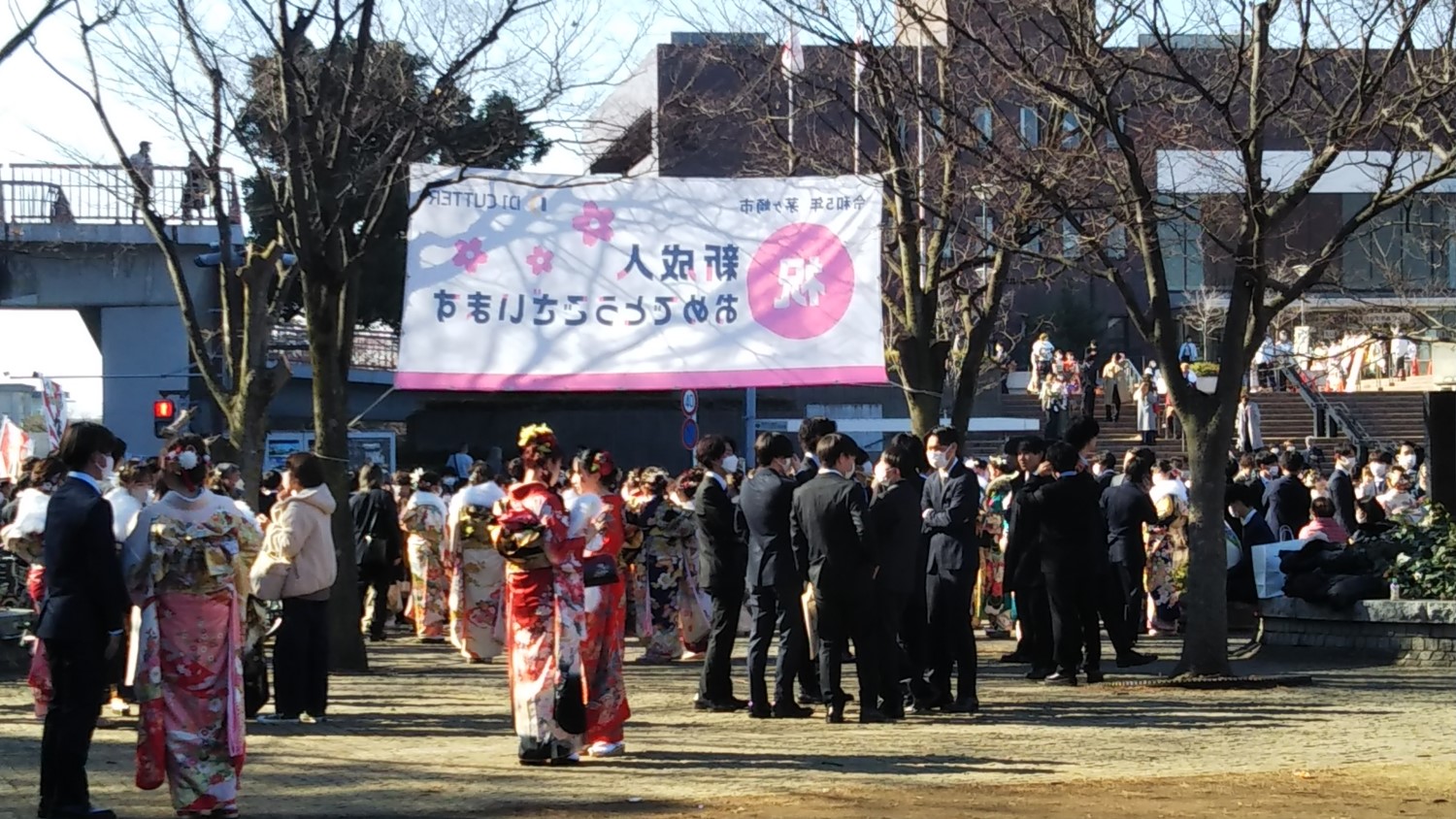
The former coming-of-age ceremonies were held under the name “the gathering for the twenty”, at the Civic Hall on January 9 (Mon). Those who had turned, or will turn 20 years old by the end of March, were divided into three groups based on school districts, and a 45-minute ceremony was held for each of the three groups separately.
As the age of adulthood was lowered to 18 on April 1, 2022, the participants are already considered to be adults. They are able to get credit cards and to contract mobile phones without agreement of their parents, and to go to vote in elections. Thus, the ceremony is more like an opportunity for class reunions, and for women to wear fine kimono. But now that they have reached 20, they are allowed to drink and smoke.
They should remember the reasons why the government has lowered the coming-of-age threshold. The biggest reason is to reflect young people’s opinions in politics in order to restrict silver democracy. Thus, they are expected to have more interest in politics. After the ceremony, Chuo Koen was thronged with new adults. Many of them probably wanted to be with their old friends, and to wear kimono a little longer.
Plat ART ~Platform of the art~

Everyone is welcome to our appreciation tour regardless of age or nationality. With the art appreciation guide, the child-care consultant and interpreter, you and your family members will enjoy the unique experience by sharing ideas and feelings about art with others.
●Date & Time: February 4th (Sat) 15:00~15:30 ●Place: CHIGASAKI CITY MUSEUM OF ART 1F
●Target people: Baby under the age of one - adult ●Participation fee: free, however, an admission ticket is necessary (Adult, 700 yen)
Reservation is required. Please write "your name, phone number, number of participants, age and a school year of children.” When you need an interpreter or sign language support, please input your needs in "an inquiry form" of our HP: Go to http://www.art-friendship.org/ - click お問い合わせ – write お名前 (your name )、電話番号 (phone number)、参加者数 (number of participants)、and お子さんの年齢と学年 (age and a school year of children)
Cooperation:International Association of Chigasaki, Joshibi University of Art and Design Alumnae Association Kanagawa
mail:npo@art-friendship.org
HP:http://www.art-friendship.org
Flowers of the season: Round leaf holly
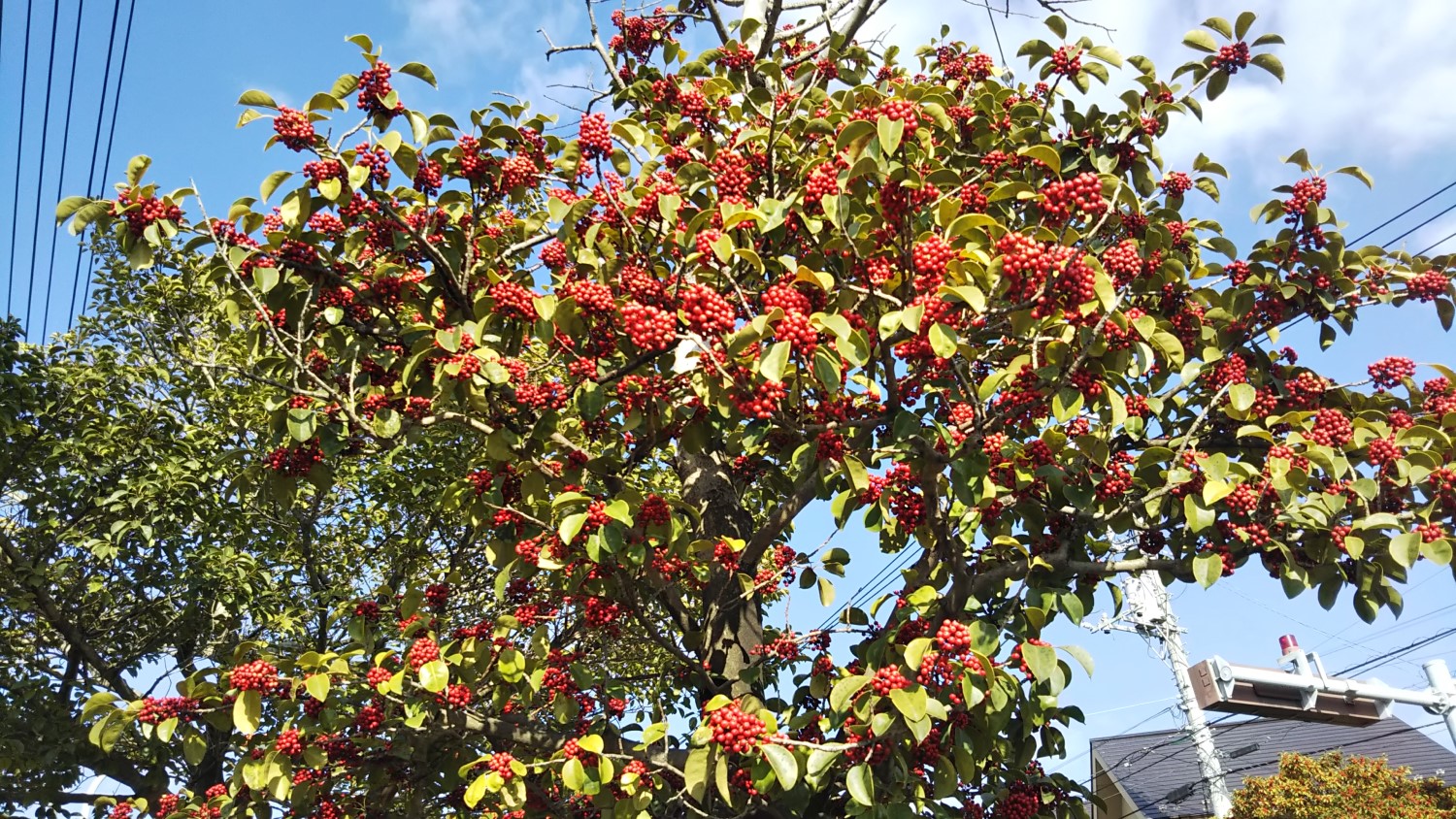
Round leaf holly is an evergreen tree, bearing a cluster of red fruits at the tip of a branch from late autumn to winter. As leaves come out from lower places of the branches, the fruits easily catch the eye of passersby. There are many trees which have red fruits in winter, but they are mostly deciduous trees, so round leaf holly’s red fruits look lively. Birds notice them quickly and convey seeds to various places.
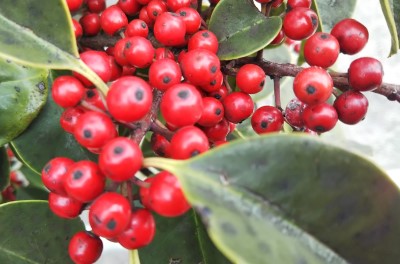
The moderately tall trees with a height of about ten meters grow in the temperate and subtropical zones, and are found in Taiwan, China and India as well as in Japan. The trees are seen in the low mountains and coastal forests in the western Japanese archipelago. Ibaraki Prefecture is the northern most habitat. They grow in sunny and half shady places. The evergreen trees are tolerant of the urban environment so they are planted in parks and along streets. In addition, many people have a preference for the tree as a garden tree. They think the tree is auspicious because its Japanese name ‘Kuroganemochi’ leads to ‘kanemochi’, which means rich people. The trees grow slowly. They shoot new greens in April. Leaves, in an alternate arrangement, have glistening dark green upper surfaces, and pale green soft lower surfaces. The elliptical-shaped leaves are five to eight centimeters long, and have sharp ends and slight ripples.
Only female trees bloom small white blossoms with six petals at axils of newly shooting branches in May and June. The tree bark is sticky so it was used to make birdlime in the past.
The photos were taken near the Enzo intersection on Chigasakichuo-dori
History of Chigasaki: Amanuma Village (2)
In the picture, major roads are drawn with thick lines. There seem to have been three: one extended to the east, running along the border with Akabane Village, another was going north, passing on the west of Gyokurinji Temple, and the other also headed north passing on the west of Jyojuin Temple. When Koide villagers went to Chigasaki through Amanuma, they used to choose either the one that passed by Gyokurinji Temple, or the one that skirted Jyojuin Temple.

The road passing by Jyojuin Temple still retains the atmosphere it had in the past, and gets to Jyokenji Temple through a golf club. See the photo above.
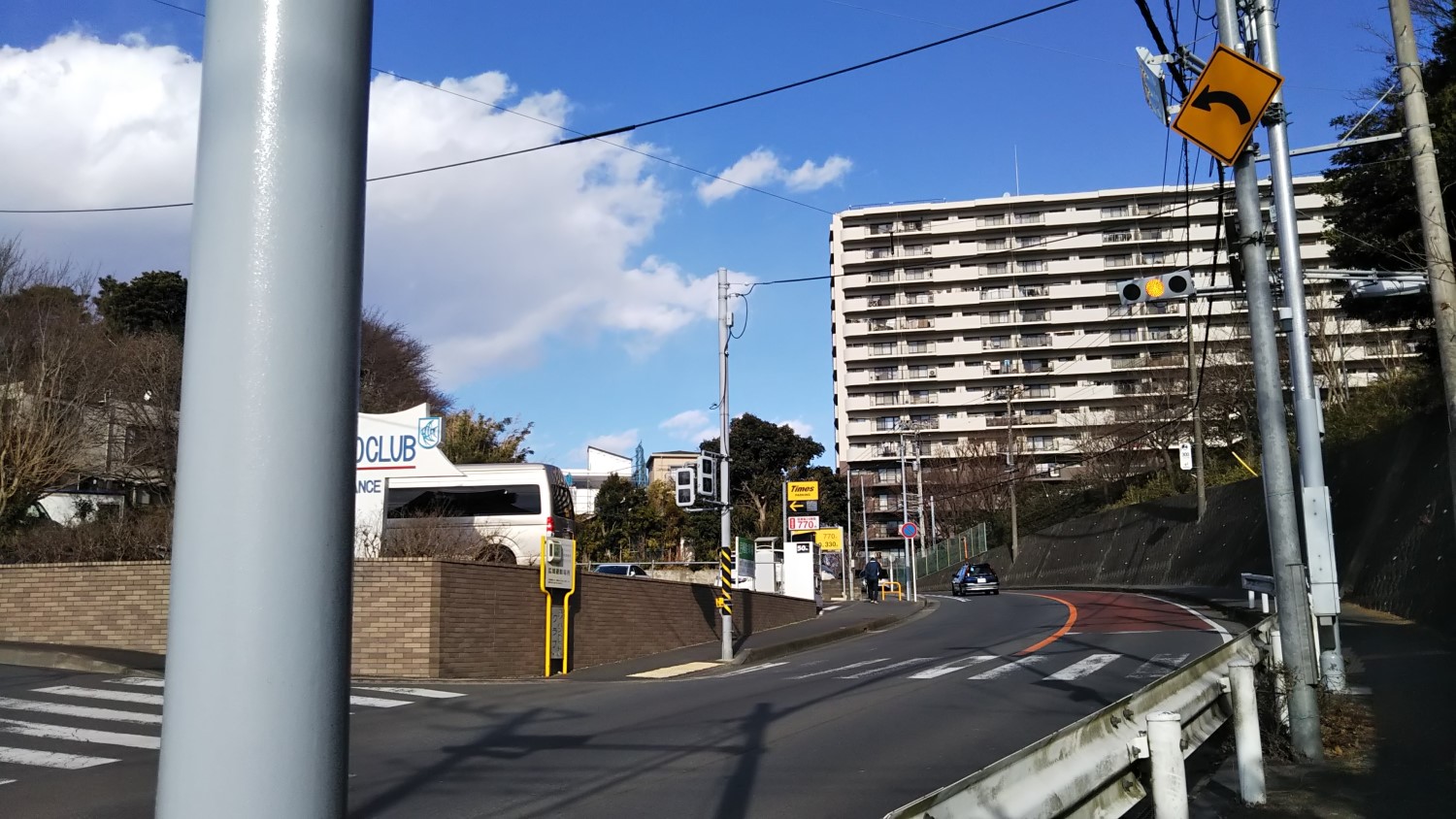
On the other hand, the road passing by Gyokurinji Temple has been thoroughly improved as the Koide prefectural road (Endo-Chigasaki prefectural road). See the photo above. At the intersection of the prefectural road and the path going up to Tonoyama Park, there stands a stone monument on which “March 26, 1921, Completion of the Renovation” is carved together with the poem “風光る道べの草の何かは嬉しく” (A nice breeze is blowing. Under the spring sunshine, even grass by the roadside makes us feel happy.). Once, the prefectural road was so steep near Gyokurinji Temple that it was quite hard for travelers to go up the slope, and many people hoped that a cutting would be made through the slope. The above poem, by an anonymous poet, shows the pleasure of completing the construction.
The area in which Tonoyama Park and the Amanuma water reservoir of the prefectural bureau of waterworks are located is called Tonoyama. “Tono-” seems to mean terraced land, a natural levee, and a slightly elevated area. The landform around Tonoyama is quite fit for the above description of “Tono-”.
皇国地誌 (the topography by the Meiji government) describes the area as Uenoyama instead of Tonoyama. The topography says: Uenoyama has fine views of Mt. Kamakura, the Cape of Miura, and Mt. Ryukou in the east-south-east, and Enoshima in the south-east; Ubajima and Hirashima come into sight as if the two islands were located just in front of the highland, and Oshima island appears far out to the sea; mountains in Hakone and Ashigara lie behind Mt. Koma and the Banyu River; Mt. Fuji rises; Mt. Aburi (Oyama) is located in the north-west; and Mt. Komagatake in Nagano prefecture appears beyond the clouds in the north-north-west; in addition, the area has good views of houses in the villages and pine trees along the coast.
Interested in Japanese proverbs?
1) 蛙の面に水 (KAERU NO TSURA NI MIZU)
KAERU means a frog, NO of, TSURA a face, NI on, and MIZU water.
As frogs live in ponds and swamp, the amphibian does not feel anything when water is splashed on its face. The saying is used to describe a person who is so shameless that they do not mind no matter how much they are laughed at, or how seriously they are criticized for their questionable behavior. People finally give up trying to educate them, and say sarcastically they have a lot of nerve.
Such a person is usually very stubborn. But stubbornness is not always a fault. It sometimes works as a driving force for them to make a great achievement. So do not give up on them easily.
The saying is in 後撰夷曲集 (Go-sen-i-kyokushu), a collection of comical and satirical tanka poems edited in 1672.
Its English equivalents are:
●Like water off a duck’s back.
●The elephant does not feel a bite.
●All is lost that is put in a riven dish.
2) 正直の頭に神宿る (SHOJIKI NO KOBE NI KAMI YADORU)
SHOJIKI means to be honest, NO of, KOBE the head, NI in, KAMI god, and YADORU to dwell
God always supports and protects honest people. Honesty is the most important character to lead everyday lives, and to establish friendly relationships with others.
Four LDP politicians were dismissed recently. They fabricated counterfeit payments, concealed their close contact with the Unification Church, and made improper remarks repeatedly. They have probably forgotten to keep telling themselves not to do anything which betrays voters’ trust in them. The proverb may have gone straight over their heads.
The saying is in 義経記 (Gikeiki), which is a military novel highlighting on Yoshitsune Minamoto and his followers, completed in the late 14th century.
Its English equivalents are:
●An honest man is the noblest work of God.
●Fortune waits on honest toil and earnest endeavor.
●God defends the right.
Invitation to Kamakura (31) Hiromoto Oe (Bimonthly serial)
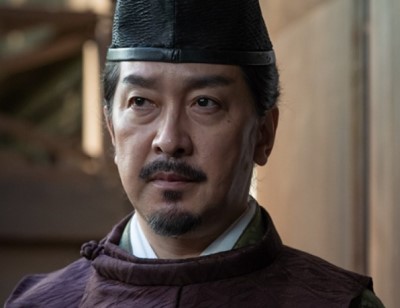
Hiromoto Oe (1148-1225) served as a trusted aide to the first shogun, Yoritomo Minamoto, and the regent Hojo clan. (Hiromoto Oe was played by Hideo Kurihara in the NHK drama "The 13 Lords of the Shogun", NHK website)
He was born to the lower-ranking noble Oe family in Kyoto, although his great-grandfather was a famous scholar. Later he was adopted by Hirosue Nakahara, and at 69, he changed his family name back to Oe. How and when did he come down to the samurai government of Kamakura?
Hiromoto excelled academically at the Imperial Court, influenced by each family’s academic skill: Chinese classics of the Oe family and Confucianism of the Nakahara family. However, as his family were minor aristocrats who were not qualified to win further promotion, his career was limited. His close brother Chikayoshi Nakahara was already on friendly terms with Yoritomo, and in 1183 he was invited to Kamakura by Yoritomo Minamoto on the recommendation of his brother. He contributed greatly to the foundation of the new samurai government in Kamakura. He was named as the head of the Board of Public Documents in 1191. The provincial officers Jito and Shugo were newly founded on his advice to strengthen the shogun’s control over the country. Moreover, he worked as a superior diplomatic negotiator with Kyoto.
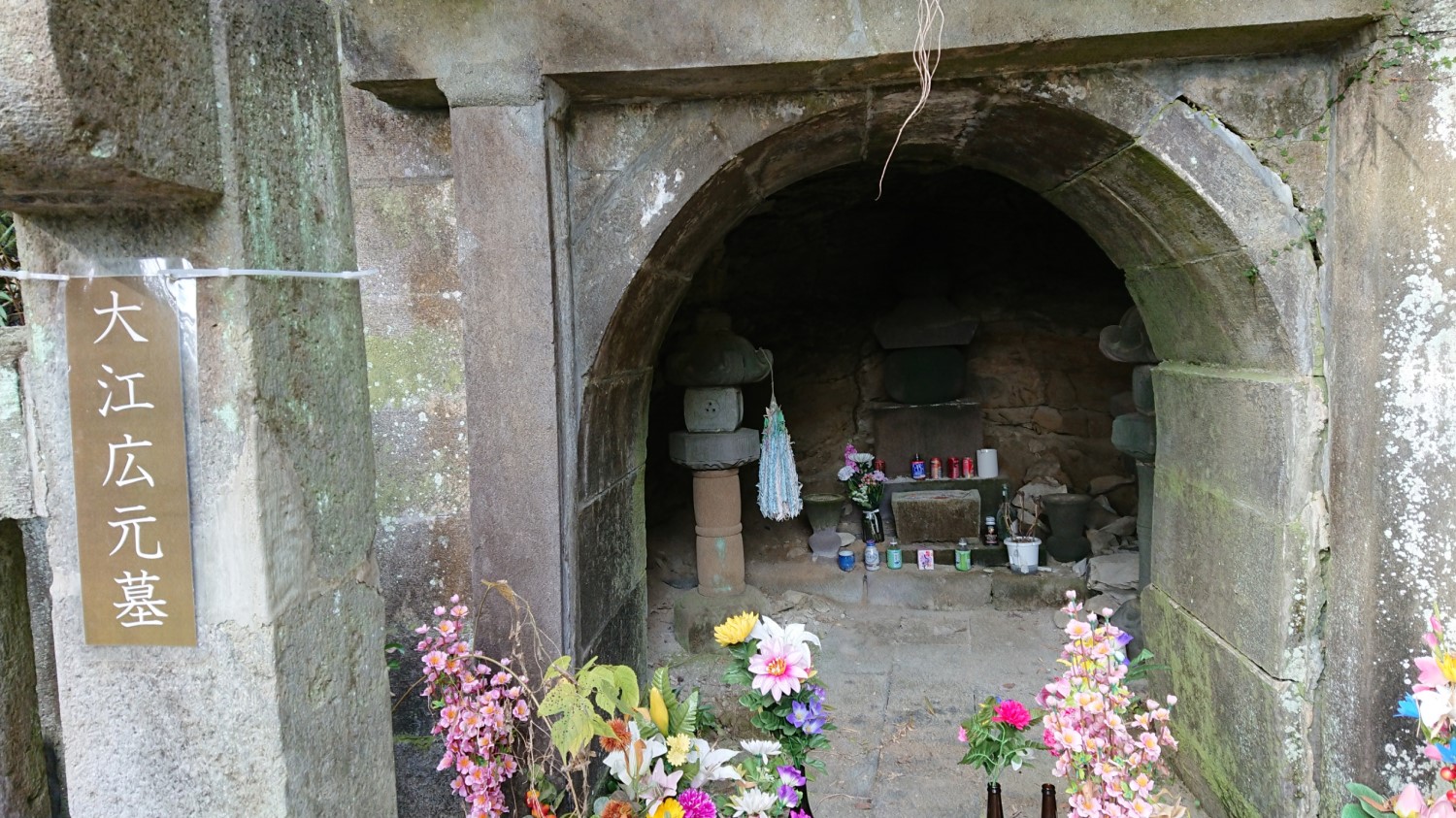
After the death of Yoritomo, Hiromoto supported the regents Tokimasa, Yoshitoki and Masako Hojo. The Hojo clan held the real power, but his rank remained as it was, meaning it was higher than that of the Hojo clan. There was no doubt that he stood first among the rest of the feudal lords in the government. When Yoshitoki noticed that Yoshimori Wada was plotting a conspiracy to crush the Hojo regency, it was Hiromoto along with Yoshitoki that thought up the killing of Yoshimori.
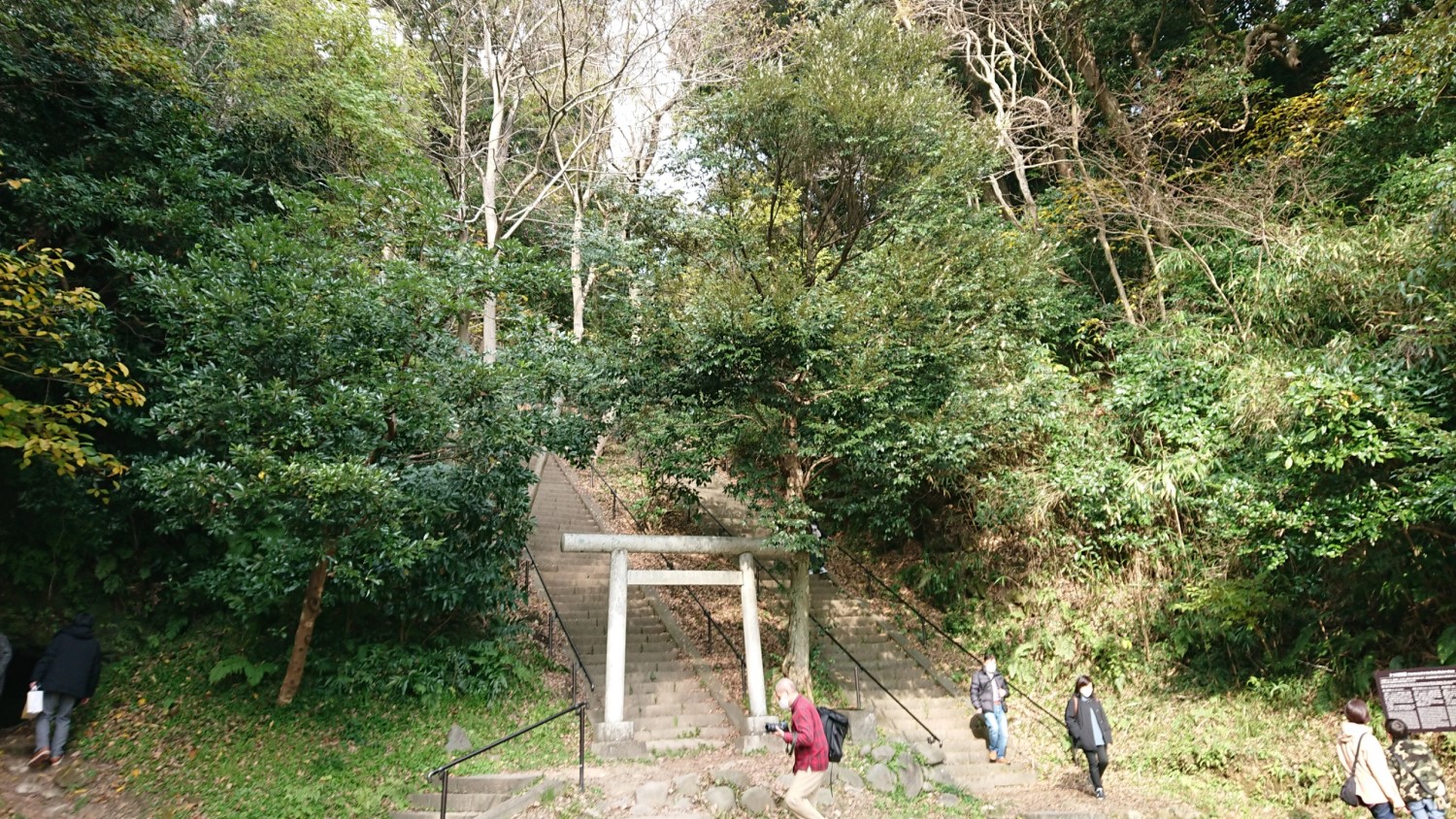
In 1221, the Jokyu Rebellion was launched when retired emperor Gotoba tried to overthrow the Kamakura government. Hiromoto devised a plan to launch a sudden attack on Kyoto. Although most vassals were so frightened and opposed to his idea, a senior lord, Yasunobu Miyoshi, spurred them to follow it. His tactics led Kamakura to an overwhelming victory, which shifted the tide of history to a samurai-centered society.
Events in December and January
The 23rd Nebuta decoration at Samukawa Shrine

A traditional year-end event, the decoration of the main gate with nebuta was carried out on December 20 (Tue). In the evening, LED lamps were turned on with nebuta dance, performed by two dancers to nebuta bayashi (nebuta festival music). The motives of the nebuta 2023 were 瓊瓊杵尊 (ninigino-mikoto) and木花咲耶姫 (konohana-sakuyahime).

Legend has it that瓊瓊杵尊 is believed to realize a bumper crop, a peaceful nation and prosperity in business, and 木花咲耶姫 is as beautiful as cherry blossoms, and is a symbol of an easy delivery and fertility. The nebuta this time also prays to the deity for world peace and the settling down of the corona pandemic.
The producer is the Aomori Nebuta-meister, Shun-ichi Kitamura, the eldest son of Renmei Kitamura, who had made nine of the previous 22 nebuta of the shrine. The dimensions of the nebuta 2023 are 9.0 meters wide, 2.7 meters tall, and 1.7 meters thick, decorated with about 500 LED lamps. The new nebuta will be lit from New Years’ Day (Sun) to February 23 (Thu, the Emperor’s birthday), from sunset to 22:00.
Dondo Yaki at Chigasaki Satoyama Koen
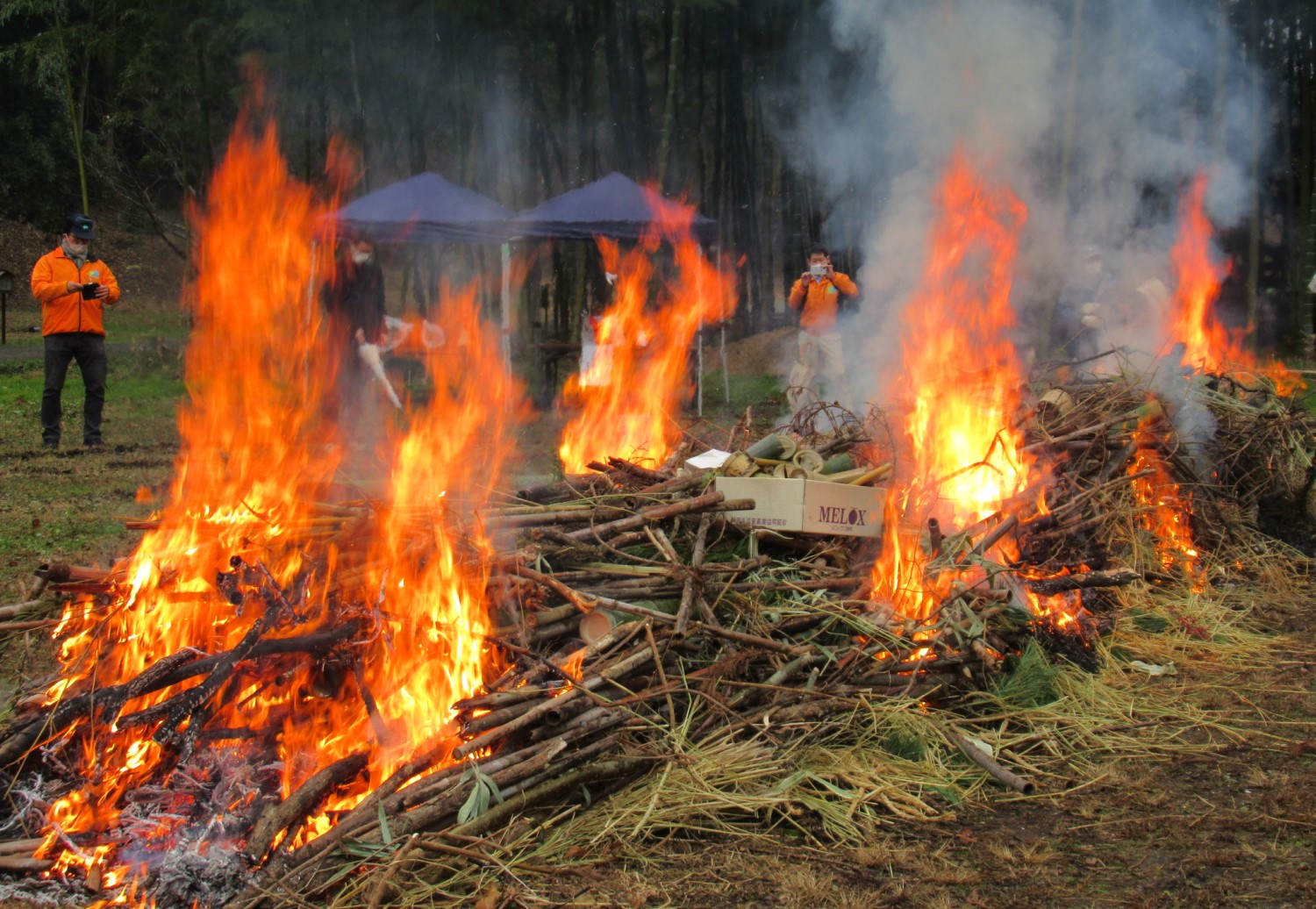
Dondoyaki, or Dosojin-sai (Festival of village people’s Guardian deity) took place at Satoyama Koen on January 14 (Sat). Dead trees were piled high at the open space near the Yato-no-Ie, or a small house in the low and wet land. The piles were set alight at around 13:00. There was a smaller turnout than usual because it drizzled in the morning.
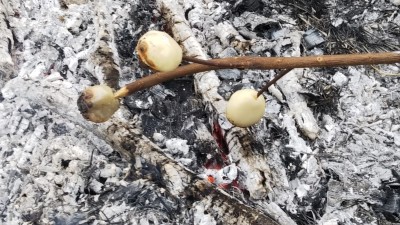
In the festival, decorations made with pine branches, sacred straw festoons, New Year’s calligraphy, talismans obtained the year before, and other new year decorations are burned at the precincts of shrines, open spaces as well as on farmland. The event is also to see off God, who visited our houses using a New Year’s decoration as a guide. In some areas, Dharma dolls and other good-luck charms are also burned. People pray for a bumper crop, prosperity in business, the safety and good health of their families. It is said dumplings grilled with embers protect people from diseases.
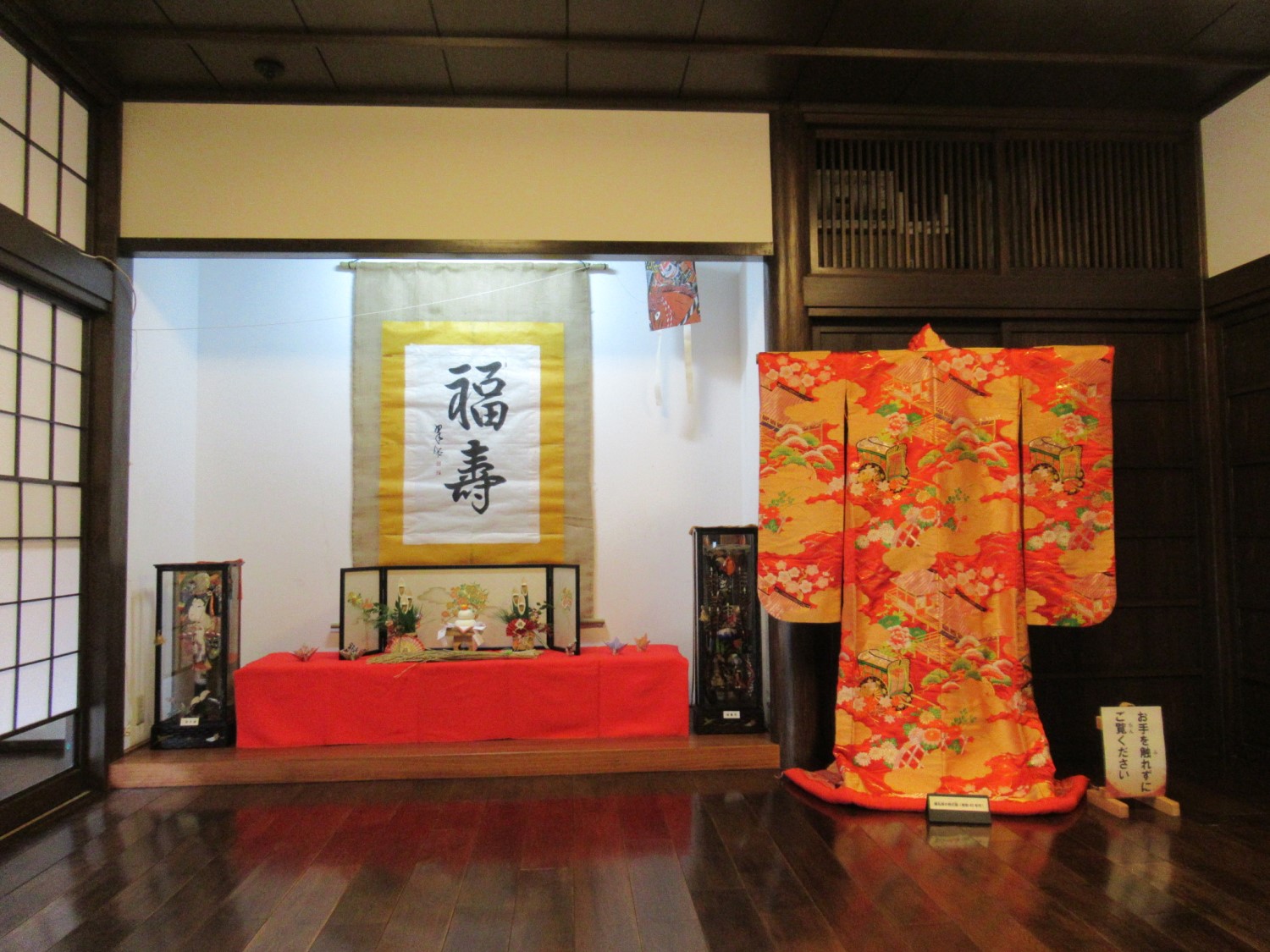
The festival dates back to the 10th century. The January event of aristocrats of the Heian period called Sagicho spread among ordinary people.
In the Yato-no-Ie, the alcove is decorated with new-year ornaments, and a colorful uchikake, a women’s bridal kimono of the 1960s, is exhibited. The alcove is going to be left as it is until January 31 (Tue).
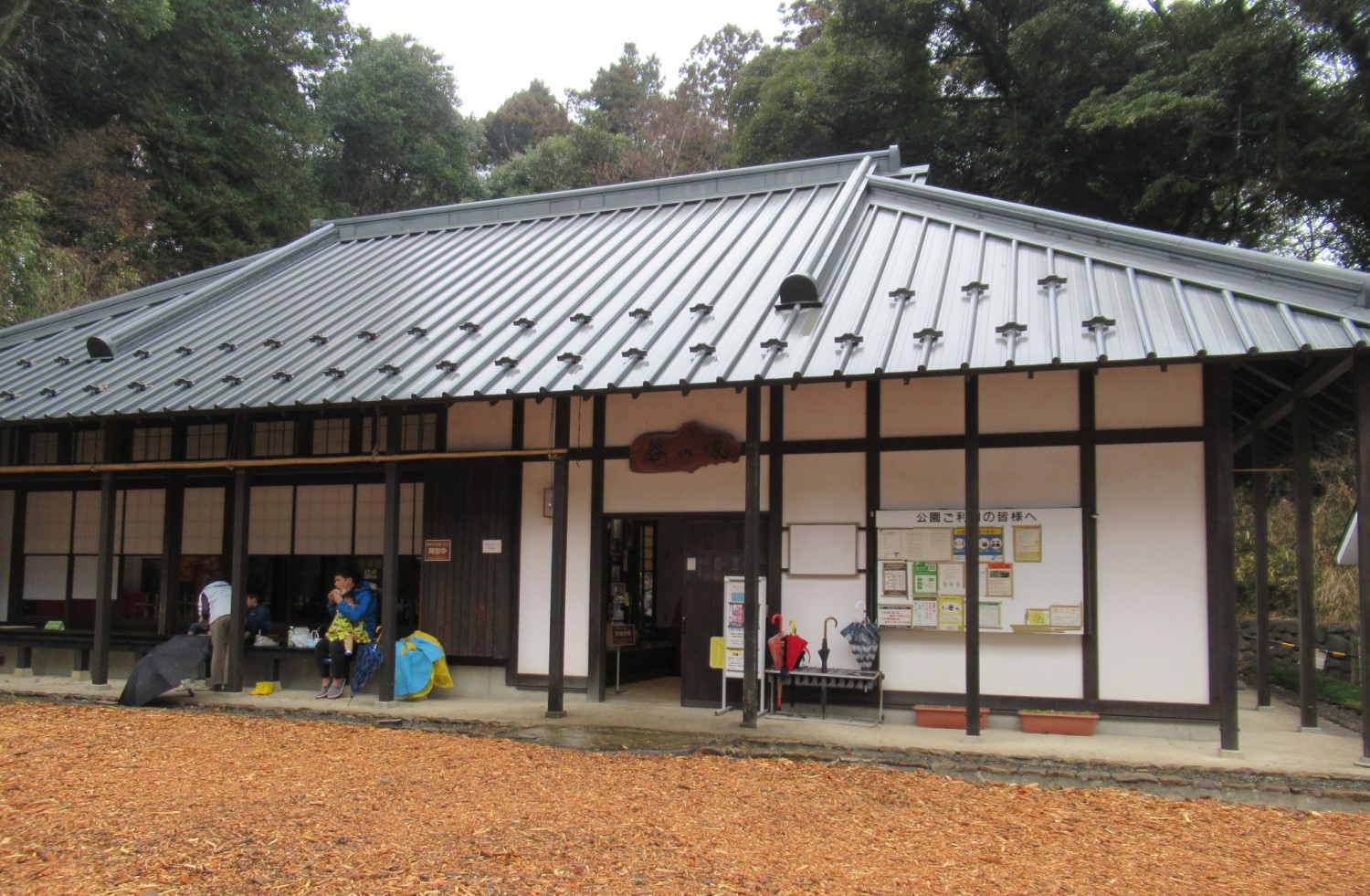
Dharma doll market

A year-end dharma doll market took place in the precinct of Dairokuten Shrine on December 27 (Tue). Shops of dharma dolls, and Shinto altar fittings lined either side of the approach. When lanterns in front of the shrine were lit at dusk, shop owners and salaried workers in the neighborhood dropped in the shrine and some of them bought dharma dolls and/or decorations. Once in a while, cheerful voices and handclaps by the sellers of dharma dolls were heard. They prayed to God for the happiness of people who bought their products.
Looking down from the nearest pedestrian bridge, the precinct lit by soft lights looked like a world of several decades ago emerging from the dark. Such an atmosphere was common to old districts developed around a shrine.
Hakone Ekiden 2023 and events on the beach
The 99th Hakone Ekiden (from Tokyo to Hakone and back by 10 runners per team) was held on January 2 (Mon) and the 3rd (Tue). On the first day, 5 runners per team ran to Hakone, 107.5 km south-west of Tokyo (each runner runs about 21.5 km). The first runners of 21 uni. teams started in front of the head office of Yomiuri Shimbun in Otemachi, Tokyo at 8:00. The Chuo Uni. team first reached Yanagishima Kaigan in the third leg (Totsuka-Hiratsuka), about 61 km from the start line, at 10:54, which means three runners carried their tasuki (a baton in relay races) at a speed of 21.0 km/hr. a little faster than the speed of the marathon gold medalist of the 2020 Tokyo Olympics, Eliud Kipchoge of Kenya, 19.8 km/hr. However, Komazawa Uni. team was the first to cross the finishing line near Lake Ashi, with Chuo Uni. being the second. The video shows the third runner of Chuo Uni. running through Yanagishima along R134
On the morning of the second day, the other 5 runners of each team carried tasuki from Lake Ashi to Otemachi, running the previous day’s course in the opposite direction, and Komazawa Uni. also came back first. Finally, Komazawa won both the first and second halves of the 2023 race with a time of 10 hr. 47 min. 11sec. for 217.1 km (20.1 km/h), followed by Chuo and Aoyama Unis.
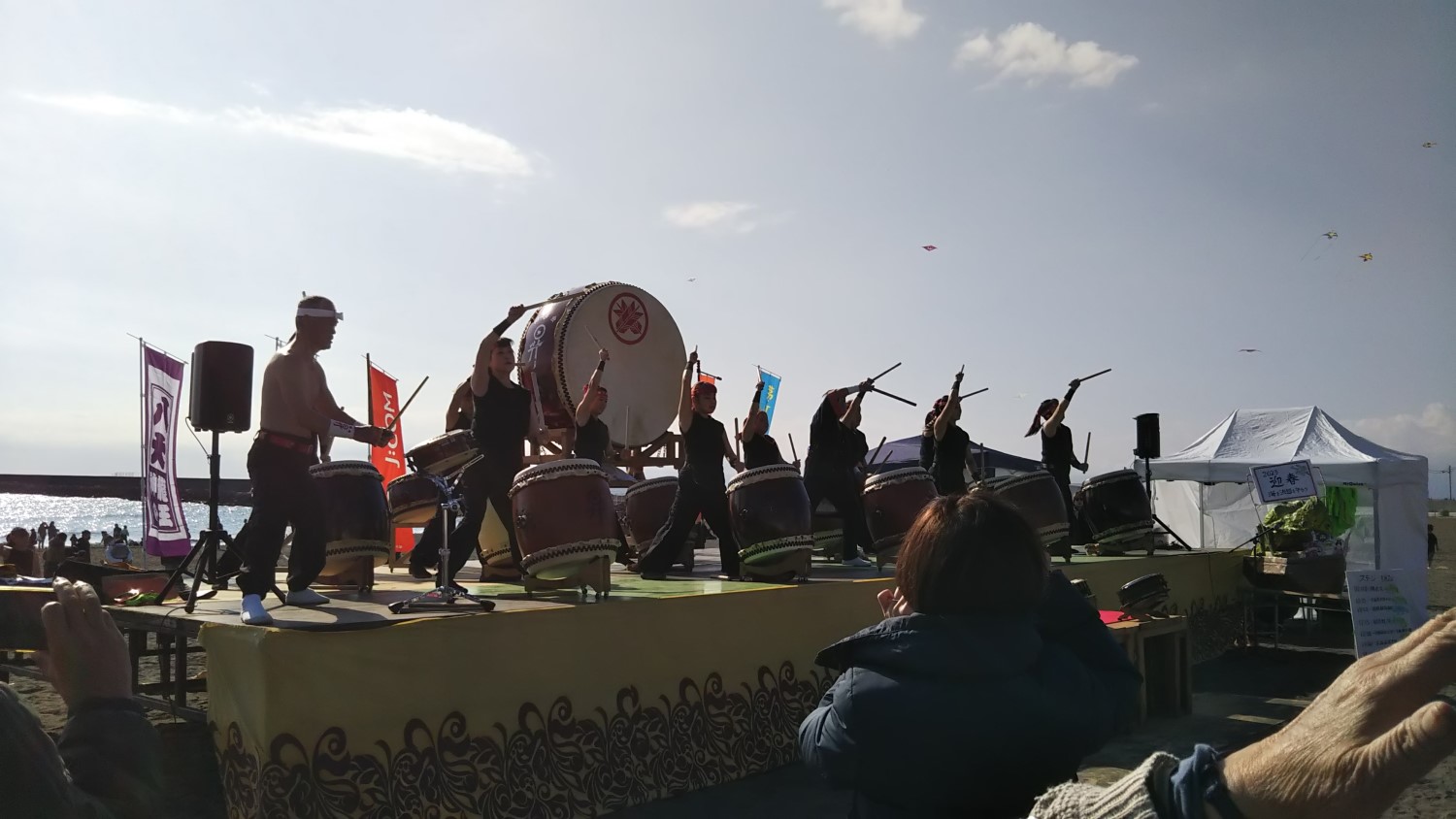
On January 2, many music bands gave performances on the Southern Beach. While the runners were passing along the beach, and long after they had gone, Japanese drums kept sounding.
The Yanagishima kite club flew their kite chains for the first time in three years. Their two kite chains matched the blue sky.

The 85th Konan Ekiden
The oldest ekiden in the prefecture was held at Yanagishima Sports Park and its neighborhood on Jan. 9 (Mon). Each team, consisting of five runners, ran a 16.45-km (men) or 14.05-km (women) circular course. There were five categories: competitions between city districts for men (30 teams) and women (16), competitions between companies, schools, and unis. for men (11) and women (2), and a competition between city districts for elementary schoolers (13).
Men’s races started at 8:30, and women’s and school children’s at 9:45. The video above shows mens' races, and that below shows women's and children's races.
(Results: winners and runner-up) ●Districts (men): Tsurumine A, Hamasuka A, (women): Nishihama A, Umeda A, and (children): Higashi-kaigan A, Umeda A
●Group (men): City Hall A, Tsurumine high school A, (women): Tsurumine high school A, City Hall A
It was regrettable that enthusiasm was limited to around the park. If the courses are set in the central area of the city, the races will become more familiar to citizens.
Chigasaki city museum of art
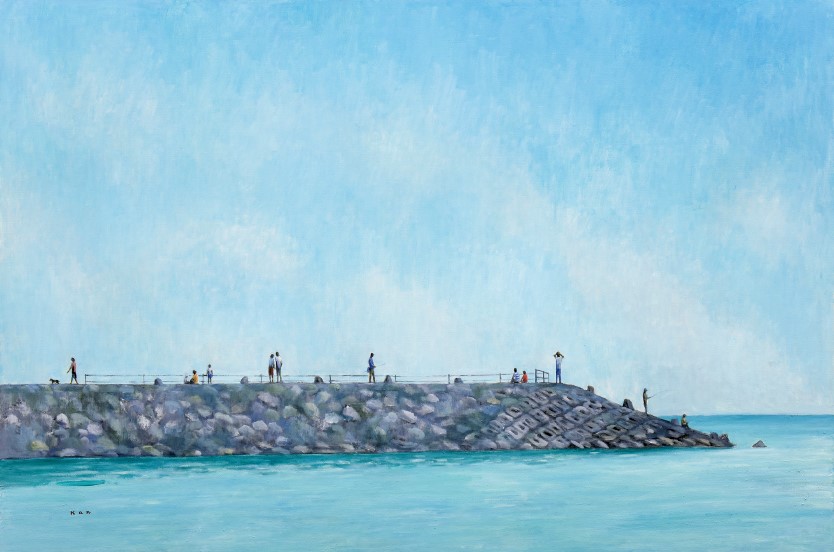
The exhibition of pictures by Kan Irie is now under way. He was born in Nikko, Tochigi prefecture in 1935. While he was a student of Tokyo University of the Arts, he ardently admired the painting style of French artist Paul Cezanne, and he studied in France from 1962 to 1964. After returning to Japan, he faced differences in landscapes and culture between France and Japan, as many Japanese painters who had studied in France did. Since 1967, he has been a citizen of Chigasaki, and came to draw the sea, sky and beach more often.

Most of the twenty-five pictures are about the scenery of Chigasaki. His pictures give visitors a sense of calm, and remind them of scenery decades ago, though more than ten pictures were drawn between 2002 and 2022. He draws open spaces with blue and green, which makes the pictures easy on the eyes.
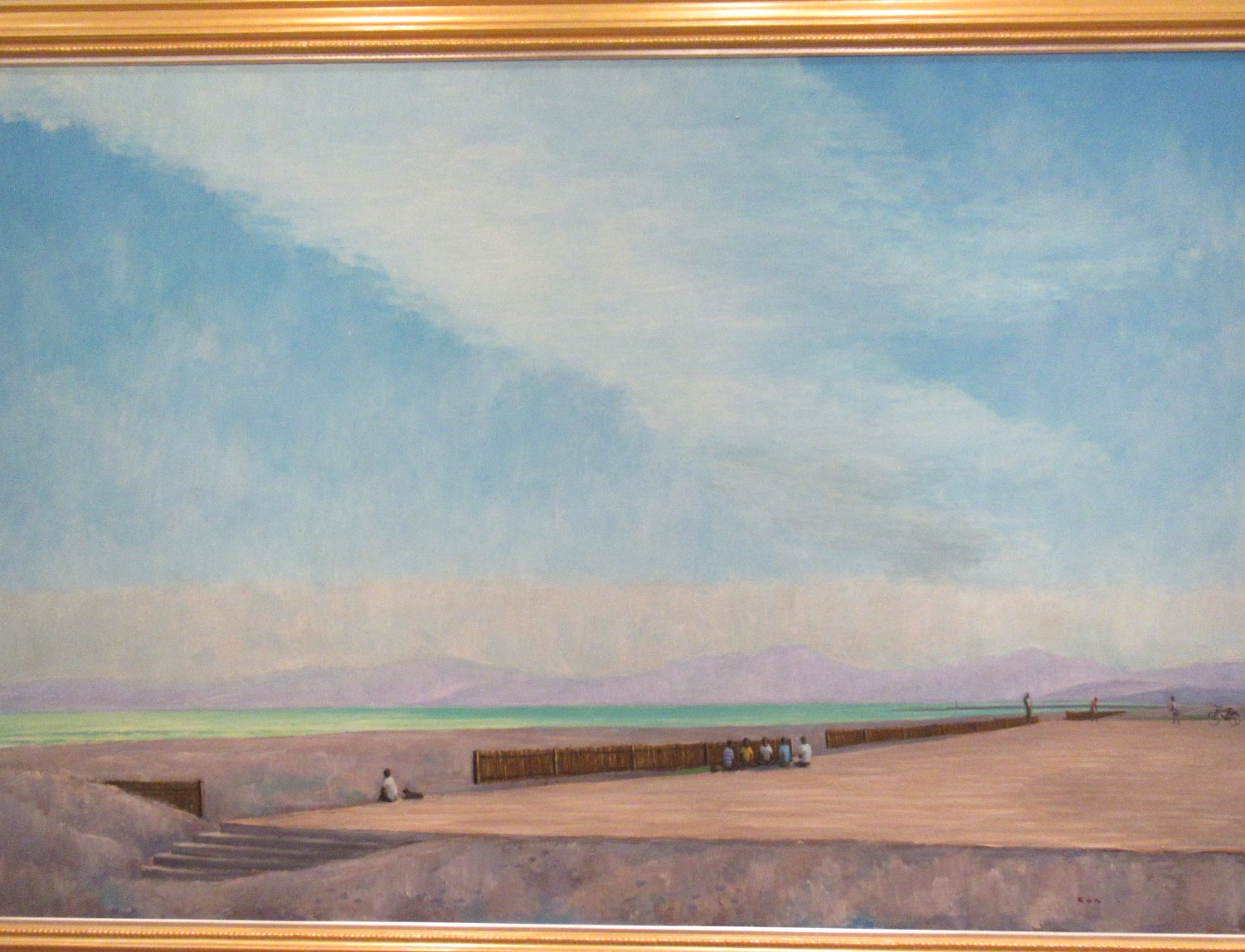
In his pictures, there are no vehicles, utility poles, signboards, or anything which might disturb the atmosphere of the pictures. This may be the reason why visitors feel tranquility about these pictures.
Events in mid-January and February
Citizen Gallery (☎ 0467-87-8384) - Admission free!
●Painting exhibition by Tansai Chigasaki: Jan. 17 (Tue) 13:00 ~ 17:00, the 18th (Wed) to the 21st (Sat) 10:00 ~ 17:00, and the 22nd (Sun) 10:00 ~ 16:00
●Calligraphy exhibition by Gagetsu calligraphy school: Jan. 27 (Fri) 13:00 ~ 18:00, the 28th (Sat) 10:00 ~ 18:00, the 29th (Sun) 10:00 ~ 17:00
●No exhibitions in February
Art soul 2023 by high school students of Chigasaki and Samukawa
Feb. 20 (Mon) – the 26th (Sun) Admission free